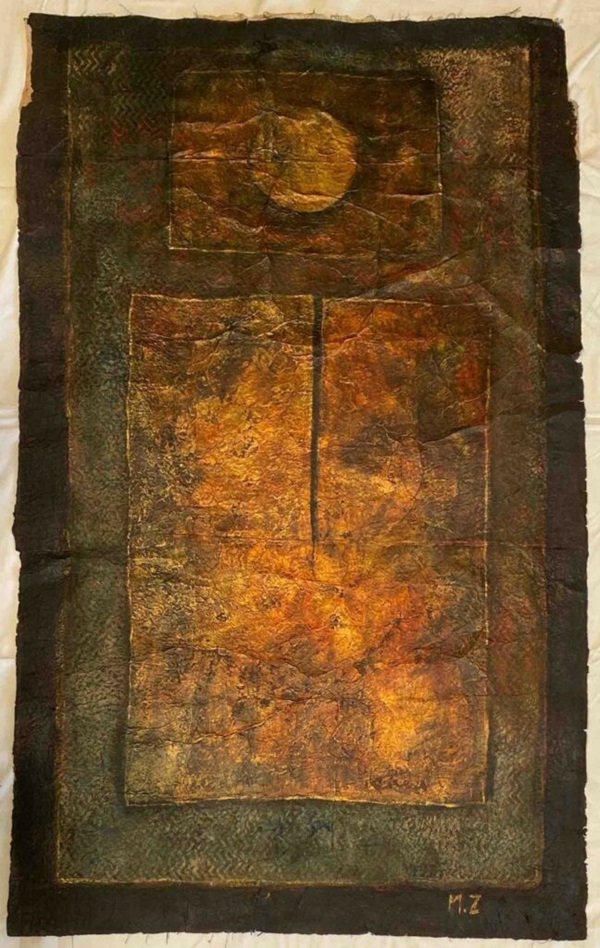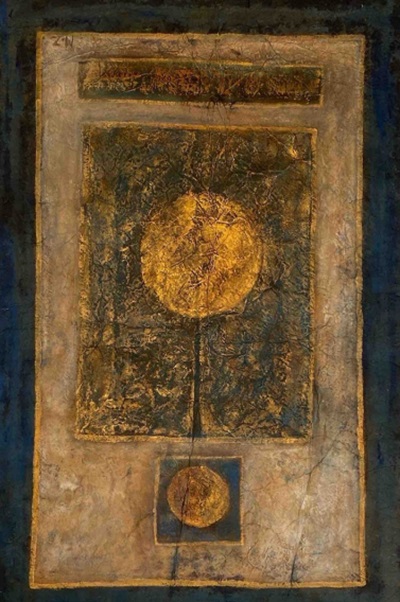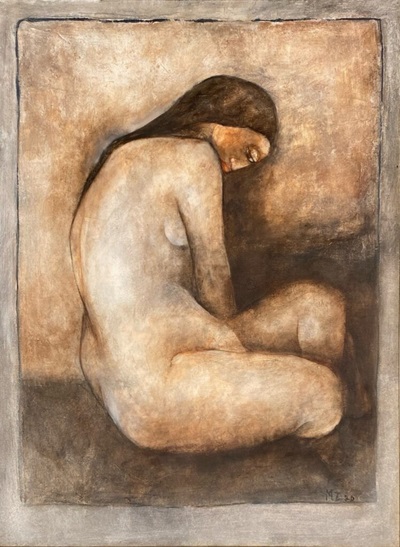Written by: Muhammad Hamza
Posted on: October 10, 2024 |  | 中文
| 中文
A painting by Mobina Zuberi displayed at her recent show 'Fragments of the Unseen.'
In these contemporary times of the art world, we have stumbled upon a vintage painting style by Mobina Zuberi. Her solo exhibition at Gallery 6, curated by Dr. Arjumand Faisal, has brought forth a new wave of abstraction in depictions of women.
Mobina Zuberi explores the drama and posture of female anatomy. The paintings are sensual to an extent, but not overly mythical or glamorized. They showcase a wide range of expressions, creating a bond with moments of instinct, desire or drama.
Her colour palette is expressive, featuring earthy tints and shades with only a few bright hues, using white to highlight figures at times. The shades on the anatomy are more vivid against the earthly drawn backgrounds, immersing the viewer and encouraging eye contact for a longer period. The pigments are oil-based, but many of her artworks also utilize oil paint washes, giving a fluid blending texture to the paintings.
Apart from painting women’s postures, which are carefully positioned to suit character and mood, she explores another genre of painting: abstraction. The compositions are vivid and bold, showing depth and emotion through which she communicates and focuses on formal elements like shape, balance and depth.
Another medium she employs for this series, apart from canvas, is handmade Nepalese paper. This unique paper is one of a kind and provides a hardened dark texture suitable for oil paint, showcasing greater depth.
Nepalese Lokta paper is an eco-friendly paper handmade from the fibre of the "Nepal Paper Plant," also known as the Daphne shrub or Lokta bush. The blend and washes from the oil paints dissolve finely in Nepalese paper, giving a texture like no other. Mobina has been actively involved in exploring women’s postures and their skin textures. Every emotion or desire can change a person’s body texture, forming a secular sense of beauty and sensuality.
Delving into Mobina’s artworks, we find fusions of female anatomy with abstract shapes and washes surrounding the medium.
The three figures sit in a posture with their heads down, draped in linen clothing that reveals some body structure, accented by a touch of red lip colour. At first glance, it’s a hearty visual; however, upon closer inspection, the darker background depicts remorse and grief infused into the scene. Mobina showcases emotions and desires through her artworks, and this piece exemplifies her feelings toward the character of a woman.
Two women sit facing each other, one displaying her nude back while the other is partially covered from shoulder to waist. The expression conveys care and support in times of distress and shame. The textures and colour pigments Mobina uses align perfectly with her motive. We cannot deny that the captured moment is truly a work of art.
The faces are visible yet slightly distorted by the texture produced. Two women sit with their legs drawn up, countering the gaze of the other, creating a beautiful interaction in the space. Mobina presents a wildly realistic portrait of women in an abyss.
The remarkable Nepalese paper has its own texture, bringing out articulated detail and depth in this abstract motif crafted for a visual sense of beauty. The golden and green hues against the dark brown background, highlighted by a hint of crimson, immerse the viewer, inviting a subtle gaze at the artwork. The motif is strictly abstract, with contrast playing a vital role in revealing the beauty of the piece. Mobina has produced many abstract depth-worthy artworks in this series, each carrying a different emotion.
Mark Rothko is known for presenting emotions through his large-scale artworks, creating a unique blend of colour and spectrum. His language was emotion through colour, and it is said that viewers often felt vulnerable, even moved to tears, while experiencing his works. This subtle language of colour and emotion is a divine experience, with deeper meanings in each stroke and blend of hues. His most famous artworks—a trio of purple-indigo pieces facing each other at the Rothko Chapel—reside permanently there, inviting people to seek enlightening ideologies from their own perspectives.

Art Work 4. Painting by Mobina Zuberi on hand made Nepalese paper in her recent show 'Fragments of the Unseen'.
Mobina has made an impact in her own language as well, producing such abstract formations, she has shared a wide array of female anatomy, and in the Artwork 05, the woman is dressed in traditional Pakistani fashion, wearing a kurti and dupatta. With untied hair and a frown, she gazes down at the floor, conveying a sense of relief mingled with fatigue. We can interpret the abstract faces in her artworks that portray her perspective on life.
In no other lifetime but this one, we experience Mobina Zuberi’s perspective and her ability to evoke emotions through colour and texture. We learn to create positive energy through artworks, engaging with and communicating through pigments and textures, blending the poetry of figures with highlights of white on browns. Experiencing her exhibited artworks is a learning curve, aiming to deepen our understanding of life in abstraction while maintaining a sense of warmth and care for life through these immersive pieces.

Painting by Mobina Zuberi

Painting by Mobina Zuberi

Mobina Zuberi's art work
You may also like: